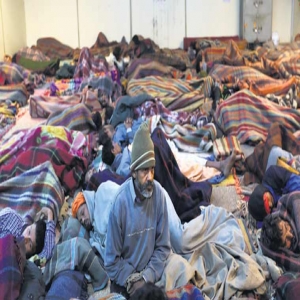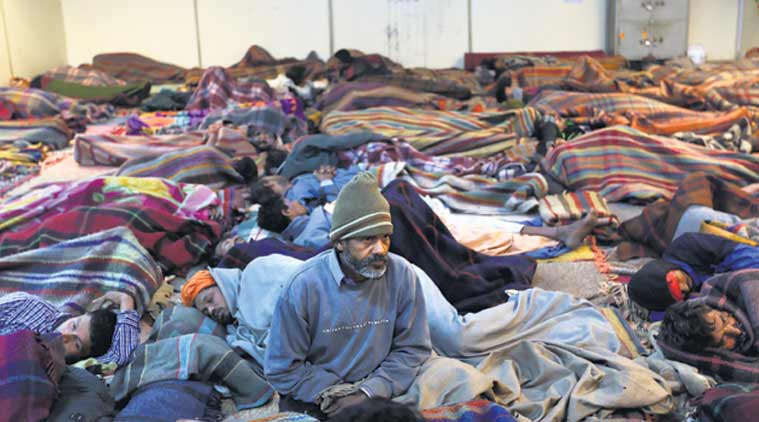
.png) M L Satyan
M L Satyan

Two days ago, I watched a YouTube video in which the pathetic conditions of the homeless and the Night Shelters in Delhi are shown. A few contradictions can be seen in every country, but we live amidst contradictions everywhere in India. Delhi, the capital city of the country, contains glaring contradictions of affluence and poverty.
In the recently concluded Delhi assembly election, many accusations were made against the Aam Admi Party. One such important accusation against Kejriwal was his luxurious house, which was unofficially christened Sheesh Mahal. A video also showed the interiors of this luxurious bungalow with a spacious garden. Kejriwal and his party always spoke against widespread corruption. But Kejriwal and some of his key colleagues were in jail. So, AAP was defeated mainly on corruption charges.
The city is known for its sprawling urban landscape and bustling life, where the affluent class has created its own luxurious housing complexes. The political leaders also enjoy superb housing facilities with spacious bungalows and gardens. This same city hides a darker truth: a growing number of people are forced to live on the roads, battling the bitter cold and severe heat. The government's claim that sufficient shelter homes are available seems to stand in stark contrast to the experiences of those who are still out in the open, vulnerable to various health issues.
Many shelter homes in Delhi are reportedly refusing entry to families with small children, leaving them nowhere to turn during the harsh winter months. According to those affected, the shelters refuse to admit families with young children, claiming that the presence of children disturbs other residents. This practice has forced many families, already struggling to survive on the streets, to endure even more challenges. This exclusionary practice is a harsh reality for many homeless families in the city. While shelters are meant to provide relief and safety, these rules create an added barrier for families who are already vulnerable, leaving them exposed to the harsh conditions of life on the streets.
Devi and her husband moved to Delhi searching for work, dreaming of a better life for their children. Instead, they found themselves struggling on the streets, their hopes slowly fading with each passing day. Like Devi, the situation is more challenging for most migrant families in Delhi, as they face additional barriers to accessing shelter homes. Many shelter homes refuse entry to families without valid identification documents such as Aadhaar cards or other government-issued IDs. This requirement leaves many migrants stranded, as they often do not possess these documents, especially if they have recently moved to the city. Furthermore, heightened scrutiny to identify Bangladeshi immigrants has led to stricter entry rules at shelter homes. This has resulted in genuine homeless individuals being denied access, even when they desperately need refuge.
"We do not have an Aadhaar card because we just moved here. When we went to the shelter, they told us they could not let us in without it. I tried explaining that we are new to the city and haven't had the chance to get our documents, but they would not listen. Now, we are left with no choice but to stay on the streets. It is so cold at night, and it is not safe at all. Every day feels like a fight to survive," said Ramesh, a migrant worker, to Media India Group. For migrant families, these policies have compounded their struggles, forcing them to live on the streets during one of the harshest winters in recent years. Many such families feel caught between bureaucracy and survival, with no clear path to relief.
The absence of comprehensive data on shelter-less people in Delhi is a template example of systemic violence against the marginalised and the collapse of housing policies too. Delhi has approximately 343 Night Shelters with a total capacity of 20,264 beds. However, a survey conducted by Shahri Adhikar Manch called Begharon Ke Sath, a coalition of NGOs working with the homeless, revealed a stark disparity. Their headcount survey found around 3,00,000 homeless people in Delhi, leaving over 2,00,000 individuals without shelter during the harsh winter months. This significant gap underscores the inadequate provision of shelter for the city's homeless population.
Many elderly individuals in Delhi are also suffering on the streets, with some taking refuge under flyovers to escape the biting cold and the scorching sun. Despite the availability of shelter homes, they are often denied entry. Rajesh, a 68-year-old man who has been surviving under a flyover near ITO for more than a year, told a press reporter in December 2024, "The shelter home said I should go to an old age home, but I do not even know where that is or how to get in. We are abandoned not just by our children but by society as well. My wife is sick, and this cold is making her worse every day. She shivers all night, and with the rain soaking through everything, it feels like death is just around the corner. At our age, we do not have much time left, but no one seems to care. All we want is a little warmth, a place to rest, and to feel human again, even for a moment."
These senior citizens, already struggling with poor health and limited mobility, find themselves in an even more precarious position. Without proper care or protection, living under flyovers exposes them to severe weather, traffic hazards, and safety risks. The lack of specialised support in shelter homes leaves them without viable options, forcing them to endure the harsh realities of life on the streets with little hope for relief.
Touted as a blueprint for economic resilience, the Union Budget 2025-26 masks a stark reality—the homeless poor. PM Modi made a promise in 2018: "By 2022, my government will ensure that everyone has a house." So, Modi and his cabinet presumed that this promise was already met. For this reason, the budget does not include a place for homeless Indians. Incredible India!